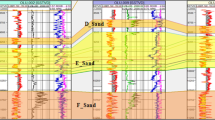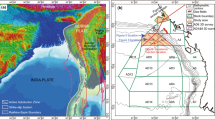Abstract
Fluvial channel sandstones form major productive reservoirs in many basins around the world. In these basins, exploration and production activities are increasingly concerned with predicting the origin and distribution of fluvial sandstone bodies, which include a wide variety of stacking patterns, ranging from narrow and single-story sandstone bodies to wide and amalgamated multi-story bodies. Determining the geometry of sandstone bodies is critical to building and conditioning 3D reservoir models which help to determine the most efficient well spacing and thus improve reservoir management. The most critical dimension to be determined is the width of the sandstone bodies, which can be estimated from five methods: (1) well correlations, (2) outcrop analogues, (3) modern analogue, (4) empirical equations, and (5) 3D seismic geomorphology. This study was initiated to determine the geometry of subsurface fluvial sandstone bodies deposited within the Epsilon and Toolachee formations, two of the most productive formations within the Cooper Basin, South Australia. The intracratonic, Late Carboniferous–Middle Triassic Cooper Basin is characterized by three major elongate, synclinal depocenters which are separated by two anticlinal, intrabasin highs; these structures were active during deposition of the units studied here. On a regional scale, the Epsilon and Toolachee formations consist of fluvial, deltaic, and shoreface deposits. The fluvial sandstone reservoirs of interest within the study area of these formations were examined by using 3D seismic and well log data. This work indicates that most of the sandstone bodies within the Epsilon and Toolachee formations cannot be resolved on seismic data because the widths and thicknesses of these sandstone bodies are not great enough to be seismically visible, especially at deep burial depths. Two correlation panels were constructed using the widespread coal bed within the Toolachee formation as a datum to determine the width of the sandstone bodies. These correlation panels with the calculated sandstone portions suggested that sandstone bodies are amalgamated within the Toolachee formation and are isolated within the Epsilon formation; however, some of these sandstone bodies cannot be correlated between adjacent wells.










Similar content being viewed by others
References
Alexander EM (1998) Lithostratigraphy and environments of deposition, Cooper Basin. Pet Geol Aust 4:69–115
Alexander EM, Hibburt JE (1996) The petroleum geology of South Australia: Eromanga Basin. South Australia. Department of Mines and Energy. Report Book 2: 96-20
Apak SN, Stuart WJ, Lemon NM (1995) Compressional control on sediment and facies distribution SW Nappamerri syncline and adjacent Murteree high, Cooper basin, Australia. Aust Pet Explor Assoc J 35:190–202
Apak SN, Stuart WJ, Lemon NM (1997) Structural evolution of the Permian-Triassic Cooper Basin, Australia: relation to hydrocarbon trap styles. Am Assoc Pet Geol Bull 81:533–555
Baillie PW, Powell CMcA, Li ZX, Ryall AM (1994) The tectonic framework of western Australia’s Neoproterozic to Recent sedimentary basins. In: Purcell PG, RR. (eds), Sedimentary basins of Western Australia, Proceedings, PESA symposium, Perth
Bridge JS, Demicco R (2008) Earth surface processes, landforms and sediment deposits. Cambridge University Press, New York, 830p
Bridge JS, Tye RS (2000) Interpreting the dimensions of ancient fluvial channel bars, channels, and channel belts from wireline-logs and cores. Am Assoc Pet Geol Bull 84:1205–1228
Brown AR (2011) Interpretation of three-dimensional seismic data. Am Assoc Petrol Geol Bull Mem 42:315p
Bryant ID, Flint SS (1993) Quantitative clastic reservoir geological modeling: problems and perspective. In: Flint SS, Bryant ID. (eds) The geologic Modeling of Hydrocarbon Reservoirs and Outcrop Analogues, International Association of Sedimentologists, Special Publication 15:3-20
Carter DC (2003) 3D seismic geomorphology: insights into fluvial reservoir deposition and performance, Widuri field, Java Sea. Am Assoc Pet Geol Bull 87:909–934
Deighton I, Draper JJ, Hill AJ, Boreham CJ (2003) A hydrocarbon generation model for the Cooper and Eromanga basins. Aust Pet Exp Assoc J 43:433–452
Fairbum WA (1992) Geometry of reservoir trends in the Epsilon formation sands, southern Cooper Basin, S.A. Aust Pet Exp Assoc J 32:339p
Gravestock DI, Jensen-Schmidt B (1998) Structural setting. Pet Geol Aust 4:33–48
Hallmann COE, Arouri KR, McKlrdy DM, Schwark L (2006) A new perspective on exploration Cooper/Eromanga petroleum province-evidence of oil charging from the Warburton Basin. Aust Pet Explor Ass J 46:261–282
Heath RS (1989) Exploration in the Cooper basin. Aust Pet Explor Ass J 29:366–378
Hill AJ, Gravestock DI (1995) Cooper Basin. In Drexel, JF, Preiss WV (eds) The Geology of South Australia, The Phanerozoic, Geological Society of South Australia Bulletin 54:78-87
Hobday DK (1987) Gondwana coal basins of Australia and South Africa: tectonic setting, depositional systems and resources. In: Scott AC (ed) Coal and Coal-Bearing Strata: Recent Advances, Geological Society of London Special Publications 32:219-233
Lang SC, Kassan J, Benson JM, Grasso CA, Avenell LC (2000) Application of modern and ancient geological analogues in characterization of fluvial and fluvial-lacustrine deltaic reservoirs in the Cooper Basin. Aust Pet Explor Ass J 40:393–415
Lang SC, Grech P, Root R, Hill A, Harrison D (2001) The application of sequence stratigraphy to exploration and reservoir development in the Cooper-Eromanga-Bowen-Surat Basin system. Aust Pet Explor Ass J 41:223–250
Lang SC, Celglar N, Forder S, Spencer G, Kassan J (2002) High resolution sequence stratigraphy, reservoir analogues, and 3D seismic interpretation—application to exploration and reservoir development in the Baryulah Complex Cooper Basin, southwest Queensland. Aust Pet Explor Ass J 42:511–522
Li ZX, Powell C (2001) An outline of the palaeogeographic evolution of the Australasian region since the beginning of the Neoproterozic. Earth Sci Rev 53:227–237
Mackie SJ, Grasso CA, McGuire SR (1995) Reservoir characterization of the Toolachee Unit ‘C’ in the Moomba/ Big Lake area: focusing on minimizing risk. Aust Pet Explor Ass J 35:92–105
Miall AD (2002) Architecture and sequence stratigraphy of Pleistocene fluvial systems in the Malay Basin, based on seismic time-slice analysis. Am Ass Pet Geol Bull 86:1201–1216
Nakanishi T, Lang SC (2001) Towards an efficient exploration frontier: constructing a portfolio of stratigraphic traps in fluvial-lacustrine successions, Cooper-Eromanga Basin. Aust Pet Explor Ass J 42:65–82
Nakanishi T, Lang SC (2002) The search for stratigraphic traps goes on-visualisation of fluvial-lacustrine successions in the Moorari 3D survey, Cooper-Eromanga Basin. Aust Pet Explor Ass J 41:115–137
O’Neil BJ (1989) The Cooper and Eromanga Basins. Aust Soc Explor Geophys, 37-86
Pinchin J, Mitchell G (1991) Seismic AVO studies in the mapping of a Permian Gas Sand at Kerna Field, Cooper Basin. APEA J 31:244p
Posamentier HW, Davies RJ, Wood LJ, Cartwright JA (2007) Seismic geomorphology—an overview. In: Davies RJ, Posamentier HW, Wood LJ, Cartwright JA (eds) Seismic Geomorphology: Geological Society of London, vol 27, Special Publication., pp 1–14
Ransom RC (1995) Practical Formation Evaluation. Wiley, New York, 484p
Rezaee M, Lemon N, Seggie R (1997) Tectonic fingerprints in siderite cement, Tirrawarra Sandstone, southern Cooper Basin. Aust Geol Soc 134:99–112
Seggie RJ (1997) Reservoir Characterization of the Moorari/Woolkina Field Complex, Cooper Basin. Aust Pet Explor Assoc J 37:70p
Shanley KW, McCabe PJ (1994) Perspectives on the sequence stratigraphy of continental strata. Assoc Pet Geol Bull 78:544–568
Stanmore PJ, Johanstone EM (1988) The search for stratigraphic traps in the southern Patchawarra Trough, South Australia. Aust Pet Explor Assoc J 28:156–166
Stuart WJ (1976) The genesis of Permian and Lower Triassic reservoir sandstones during phases of southern Cooper basin development. Aust Pet Explor Assoc J 16:37–42
Thornton RC (1979) Regional stratigraphic analysis of the Gidgealpa Group, southern Cooper basin, Australia. Geol Surv S Aust Bull 49:140 p
Veevers JJ, Powell CM (1984) Uluru and Adelaidean regimes. In: Veevers JJ (ed) Phanerozoic Earth History of Australia. Clarendon Press, Oxford, pp 329–339
Williams BP (1982) Facies analysis of Gidealpa Group reservoir rocks, southern Cooper Basin, South Australia. Report for South Australia Oil and Gas Corporation Pty Ltd (unpublished).
Williams BP (1984) Reservoir geometry and alluvial architecture of the Toolachee Formation, Moomba Field, south Cooper Basin. Geol Soc Aust Abstr 12:522–533
Acknowledgments
This project was funded by the Deanship of Scientific Research (DSR), King Abdul-Aziz University, Jeddah, under grant no. (4/145/1432). The author, therefore, acknowledges with thanks DSR technical and financial support. Primary Industries and Resources of South Australia (PIRSA) is gratefully acknowledged for providing 3D seismic and well log data. A special thank goes to the faculty members of the Department of Petroleum Geology and Sedimentology for their help and support during this study.
Author information
Authors and Affiliations
Corresponding author
Rights and permissions
About this article
Cite this article
Alqahtani, F.A. Subsurface analysis of fluvial systems of Epsilon and Toolachee formations, Cooper Basin, Australia. Arab J Geosci 8, 3285–3297 (2015). https://doi.org/10.1007/s12517-014-1344-8
Received:
Accepted:
Published:
Issue Date:
DOI: https://doi.org/10.1007/s12517-014-1344-8




